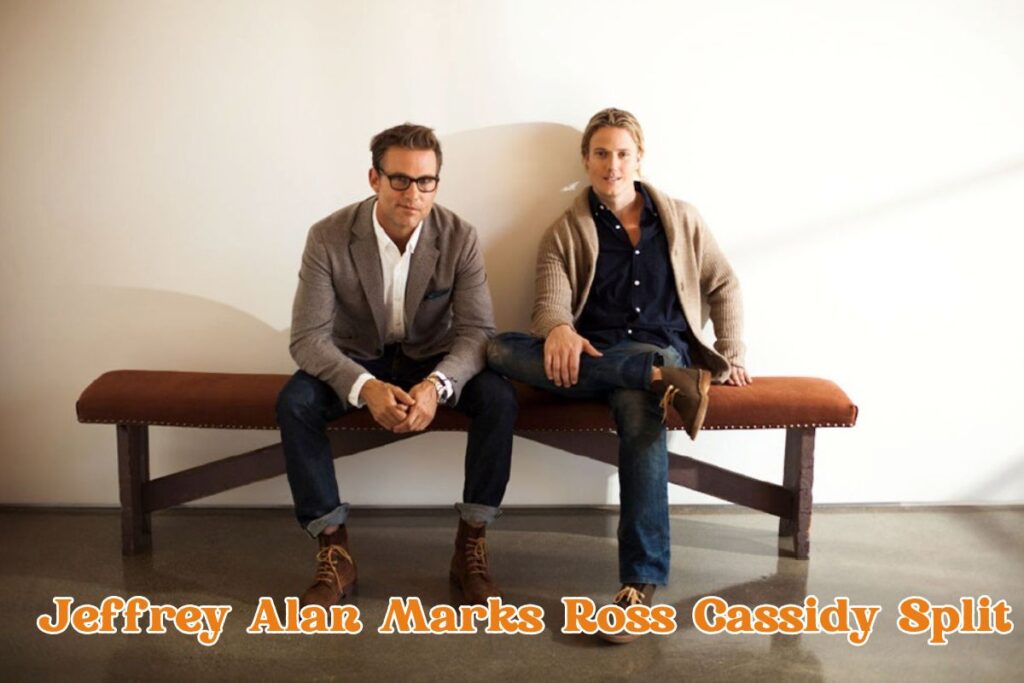
Jeffrey Alan Marks and Ross Cassidy were once celebrated as one of the most dynamic duos in the design world, combining their unique visions to create stunning interior spaces. Their partnership was not just a blend of style, but also a strategic collaboration that resonated with audiences and clients alike. Known for their work on the popular reality show Million Dollar Decorators, the two carved out a niche that turned them into household names in the design industry. However, after years of success and fame, their relationship came to an unexpected end, leaving many to wonder what caused this celebrated duo to part ways.
Their journey together was filled with creative triumphs, but behind the scenes, their personal and professional lives began to take different directions. This article takes a closer look at their iconic partnership, the rise to fame, the dynamics that made them successful, and the reasons behind their split.
Jeffrey Alan Marks and Ross Cassidy Split
Jeffrey Alan Marks and Ross Cassidy gained national attention through their appearances on Million Dollar Decorators, a show that followed the lives of top-tier interior designers working with wealthy clients to transform their homes. Premiering in 2011, the series became a major hit on Bravo, drawing in viewers who were eager to see how these design professionals worked their magic on multimillion-dollar properties.
Marks, known for his relaxed California style, and Cassidy, with his more daring and contemporary approach, quickly became the standout pair on the show. Their contrasting styles created a compelling dynamic, making them a perfect fit for television. They blended practicality with extravagance, and their passion for design was palpable, captivating audiences with every project they undertook.
Beyond their television appearances, Marks and Cassidy’s work in the design world garnered attention from top clients. Their ability to combine luxurious elements with a touch of personal style made their designs feel both timeless and accessible. This strong public image helped solidify their reputations as a power couple in interior design. Their celebrity status in the design community grew exponentially, and both gained recognition as leaders in the field, working on high-profile projects, attracting major media coverage, and collaborating with other industry heavyweights.
The Dynamics of Their Professional Partnership
The professional partnership between Jeffrey Alan Marks and Ross Cassidy was based on their complementary design philosophies. Marks, known for his California aesthetic, embraced a laid-back and sophisticated style that incorporated natural materials, clean lines, and an earthy palette. His approach brought a sense of calm and timelessness to the spaces he worked on.
In contrast, Cassidy’s style was much more bold and avant-garde. He was drawn to dramatic contrasts, modern design elements, and vibrant colors, pushing the boundaries of what traditional interior design could look like. The two of them balanced each other out, creating spaces that blended elegance with excitement. Their unique dynamic was a key factor in their success, as they appealed to clients with different tastes and preferences.
Together, they managed to bridge the gap between classic luxury and contemporary design, creating spaces that were both functional and artistic. Their ability to collaborate while still maintaining their distinct design identities set them apart from other interior designers in the industry.
Challenges of a Public Life
As much as their professional lives seemed to be thriving, the pressures of being in the public eye began to take a toll on their personal relationship. Living under constant scrutiny from both fans and the media meant that every aspect of their lives, including their creative decisions, was closely examined and critiqued. The stress of balancing such high-profile careers, along with the demands of their personal lives, eventually created a rift between the two.
Fame can often complicate personal relationships, and Marks and Cassidy were no exception. The public’s fascination with their partnership likely added pressure to an already intense industry. The constant travel, tight deadlines, and long hours may have strained their bond, and it became apparent over time that their professional success was no longer enough to sustain their personal connection.
Their partnership was also heavily affected by the increasing demands of their individual careers. As both men grew in their professional capacities, the space for collaboration grew smaller, and their personal visions began to diverge. While they had previously thrived on working together, they were no longer in sync with each other’s goals, leading to frustration and distance.
Key Reasons for the Split: Speculation vs. Facts
The exact reasons behind Jeffrey Alan Marks and Ross Cassidy’s split remain largely speculative. While neither party has gone into great detail about the personal reasons for their separation, several factors likely played a role in their decision to part ways.
One of the main reasons cited is their diverging career aspirations. As their careers grew, both Marks and Cassidy became more focused on their own paths. Marks, known for his luxury design work, began to expand his brand into new areas, including home furnishings and product lines. Meanwhile, Cassidy seemed to lean toward a more independent, innovative approach to design, exploring new avenues that differed from Marks’ more traditional style.
Personal struggles, too, may have contributed to the split. The pressures of maintaining a high-profile partnership while managing their personal lives created tension. Both men have expressed in past interviews the challenges of balancing fame with personal fulfillment. Cassidy, in particular, was vocal about wanting to create a legacy on his own terms, which might have led to a shift in his priorities.
Creative differences also likely played a role. As designers, Marks and Cassidy had different visions and approaches to their work. While their contrasting styles initially worked in their favor, over time, these differences may have become a source of conflict. What started as a partnership based on mutual respect for each other’s abilities might have morphed into a more competitive dynamic, with each designer wanting to push their own brand forward.
Insights from Industry Insiders and Trusted Sources
Industry insiders suggest that while the split was amicable on the surface, it was a long time coming. As Marks and Cassidy’s individual brands grew, the inevitable challenges of sharing creative control and maintaining personal harmony in such a high-stress industry became too much to overcome. Despite the public nature of their breakup, many close to the couple noted that they remained supportive of each other, understanding that both were trying to navigate the evolving demands of their careers.
Ross Cassidy is a well-known figure in the interior design world, often recognized for his work alongside Jeffrey Alan Marks. Although specific details about his age and personal life remain largely private, it’s clear that his professional contributions have made him a respected name in design. Cassidy’s design style is characterized by storytelling and creating unique, meaningful spaces that resonate with those who experience them. After his partnership with Jeffrey Alan Marks ended, Ross Cassidy continued to carve his own path in the industry, focusing on residential projects and set designs.
As for his relationship with Jeffrey Alan Marks, they were partners both professionally and personally for a significant time, but they separated, with both continuing to thrive in their respective careers post-split.
Regarding their financial status, specific net worth figures are not readily available for Ross Cassidy. However, it’s evident that his successful ventures in interior design and his continued work after the split contribute significantly to his financial success.
Jeffrey Alan Marks, a prominent interior designer, has also enjoyed considerable success in his career, maintaining a high profile in the design world post-split. His net worth is estimated to be substantial, fueled by his design work, branding, and product lines
The Announcement and Public Reaction
When the announcement of the separation between Jeffrey Alan Marks and Ross Cassidy came to light, it captured the attention of both the design community and the public at large. As a duo, they were a power couple in the design world, known for their collaboration on various high-profile projects and their successful run on Million Dollar Decorators. Naturally, their split generated significant buzz across social media platforms and design circles.
Many social media users expressed surprise and sadness over the end of their professional and personal relationship. Both Marks and Cassidy had built a strong, loyal fanbase, and their partnership was considered a model of creative collaboration in the design world. While some fans speculated on the reasons for the breakup, others focused on the continued success of the two individually, expressing hopes that both would continue to thrive in their respective paths.
The industry response was largely positive, with many colleagues and fellow designers praising both Marks and Cassidy for handling the split with grace. Both public figures issued statements thanking their fans for support while emphasizing their commitment to their respective careers. This mature handling of the breakup reinforced their professional integrity and assured clients and industry peers that their work would continue to be of the highest quality. In the wake of the separation, both men received a wave of support from the design world, who appreciated their professional approach to personal challenges.
Impact on Their Careers
The separation had distinct impacts on the careers of Jeffrey Alan Marks and Ross Cassidy, but both managed to navigate this change with remarkable skill.
For Jeffrey Alan Marks, the split became an opportunity to expand his already established legacy in the interior design world. Marks, whose work has always embodied luxury and sophistication, used the moment to further his focus on high-end design projects. His post-split career saw him broadening his scope by introducing product lines such as furniture and décor items that align with his refined design style. With his established reputation and a strong social media presence, Marks’ ability to attract high-profile projects has remained unshaken. As a designer, Marks has embraced the opportunity to solidify his influence in the luxury interior design space, collaborating with leading brands and continuing to garner recognition for his timeless, elegant aesthetic.
Meanwhile, Ross Cassidy took a more independent route after the split, embracing his creative freedom to pursue a bolder, more individualistic style. Known for his avant-garde approach to design, Cassidy used the separation as a platform to experiment with new artistic ideas and explore projects that spoke to his evolving tastes. He began to focus more on residential design and set decoration, creating immersive spaces that highlight his innovative vision. Cassidy’s willingness to break free from convention allowed him to carve a unique niche for himself in the design world. His post-split designs have garnered attention for their ability to push boundaries and spark conversations, making him a respected figure in the industry for those seeking unconventional, yet highly impactful design solutions
Business Aftermath: Separation of Ventures
When two successful designers part ways, especially after collaborating for many years, untangling shared projects and business ventures is no small feat. After the split, both Jeffrey Alan Marks and Ross Cassidy faced the challenge of addressing ongoing client concerns and ensuring that their individual businesses operated smoothly.
The duo had several ongoing projects and clients that relied on their shared expertise and collaborative vision. To navigate this transition, both Marks and Cassidy made it clear to clients that they would continue to honor existing commitments and deliver high-quality results. This reassured clients that the integrity of their work would remain intact despite the changes in their professional relationship. Additionally, Marks and Cassidy’s business dealings were carefully separated, with each maintaining distinct design firms. This separation allowed both designers to focus on their individual paths without overlap, ensuring that they could pursue their own creative and professional endeavors.
In terms of business, the separation also marked a redefinition of their roles in the design world. Jeffrey Alan Marks, with his emphasis on luxury and elegance, continued to attract high-end clients, further building his empire. On the other hand, Ross Cassidy’s more bold, artistic approach gave him the opportunity to tap into a niche market of avant-garde clients and design enthusiasts seeking distinctive, unconventional interiors.
From Collaboration to Competition
With their professional partnership now dissolved, the transition from collaboration to competition was inevitable. While both Marks and Cassidy continue to respect each other’s work, their paths moving forward have taken distinctly different directions. This shift is not only a personal one but also one that affects their professional interactions within the interior design space.
As independent entities, both Marks and Cassidy are now competing for similar clientele, particularly those seeking high-end and unique design experiences. Jeffrey Alan Marks continues to uphold his reputation for luxurious, timeless design, while Ross Cassidy’s daring, forward-thinking concepts provide an alternative to more traditional design preferences. The competition between the two is likely to push both designers to elevate their work even further, ultimately benefiting their clients by offering a broader range of design options.
For the design industry, this shift from collaboration to competition creates a dynamic environment where both designers challenge each other to innovate. It remains to be seen how their evolving careers will affect the broader market, but both are undeniably forces to be reckoned with in the world of interior design.
Lessons for Couples in Business
The professional and personal relationship between Jeffrey Alan Marks and Ross Cassidy offers valuable lessons for couples considering working together. One key lesson is the importance of setting clear boundaries between personal and professional life. While their shared passion for design led to a successful partnership, the line between the two can blur when both the business and personal relationships are intertwined. Ensuring that each partner has their own space and autonomy in the workplace is vital. Open and honest communication is equally crucial, especially when navigating the challenges of balancing creative differences and professional goals.
For couples working in business, it is essential to discuss long-term aspirations early on, align their career goals, and address potential areas of tension. In the case of Marks and Cassidy, the shift in their creative visions and career directions led to the dissolution of their partnership, highlighting the importance of adaptability and ongoing communication. As their paths diverged, the breakup could have been less painful if both had clearer understandings of how their evolving careers would impact their business ventures.
What’s Next? The Legacy of Marks & Cassidy
Despite their split, both Marks and Cassidy remain significant figures in the design world. Looking forward, their legacy will likely continue to shape the industry in different ways. Jeffrey Alan Marks, with his refined, luxurious approach to design, will continue to appeal to high-end clients and expand his influence in luxury home decor and lifestyle products. His name has become synonymous with sophisticated design, and the market for his brand remains robust. There are expectations that Marks will leverage his experience to further develop his brand with collaborations and high-profile projects, ensuring his continued prominence in the luxury design sector.
On the other hand, Ross Cassidy’s legacy is likely to evolve as he embraces a more avant-garde and boundary-pushing approach to design. His commitment to exploring new artistic avenues will likely carve a niche for him in the world of bold, unconventional design. Cassidy has the potential to influence future generations of designers looking for ways to break free from tradition and embrace innovative concepts. As the industry continues to embrace diversity in design, Cassidy’s unorthodox style may lead him to greater recognition as a pioneer in bold, experiential spaces.
Predictions for Their Future Endeavors and Lasting Influence on Design
Both Marks and Cassidy are poised to continue thriving independently in the design world. Marks’ success in high-end luxury design will likely see him expand into new markets, including international projects, as his reputation continues to grow. His role as an established figure in luxury interior design makes him a valuable asset for high-profile clients, ensuring that his business will continue to evolve with the times.
For Cassidy, his focus on artistic exploration will keep him relevant in the realm of contemporary design. His work may begin to cross into other artistic disciplines, such as fashion, fine art, or even performance art, creating opportunities for cross-industry collaborations. Cassidy’s boldness could lead to unexpected projects that blend design with experiential art, capturing the attention of those in search of groundbreaking aesthetics. As the design world evolves to embrace diverse voices and fresh perspectives, Cassidy’s influence may rise even higher.
Fan and Industry Perspectives
The end of Marks and Cassidy’s partnership generated an outpouring of support from both fans and industry peers. Fans, especially those who followed the duo’s journey on Million Dollar Decorators, expressed sadness over the split, sharing fond memories of their time working together. Many saw the end of their collaboration as the conclusion of an era in design, but there was also a sense of optimism for what the future would hold for each designer. The admiration for their unique contributions to design has only grown as fans respect their ability to gracefully navigate such a significant change.
Industry insiders, including fellow designers, expressed similar sentiments. Many viewed the breakup as a natural evolution of both Marks’ and Cassidy’s careers. Their talents were widely respected, and it was understood that both men needed room to grow creatively. The design world continues to celebrate their individual achievements, recognizing that both Marks and Cassidy have left an indelible mark on the industry. Their time working together has set a high standard for collaboration, and their influence continues to inspire both established designers and emerging talents alike.
While the split of this iconic duo may have surprised some, their professional trajectories show that their individual paths will continue to shape the future of interior design in significant ways. The evolution of their careers is a testament to their resilience and passion for their craft, and their legacy is far from over.
Faqs’s
1. What led to the split between Jeffrey Alan Marks and Ross Cassidy?
The split between Jeffrey Alan Marks and Ross Cassidy was a result of diverging career aspirations and creative differences. After working together on numerous projects, they found that their professional paths no longer aligned, with Jeffrey Alan Marks focusing more on expanding his business, while Ross Cassidy sought to pursue individual creative freedom. The pressures of fame, combined with personal and professional struggles, also contributed to the separation.
2. How did their appearance on Million Dollar Decorators influence their careers?
Their appearance on Million Dollar Decorators in 2011 catapulted Jeffrey Alan Marks and Ross Cassidy into the limelight, making them household names in the design world. The show showcased their distinct yet complementary design styles, blending sophistication with bold innovation. It also gave them access to a broader client base, elevating their brand to a luxury design powerhouse.
3. What is Jeffrey Alan Marks’ approach to design after the split?
After the split, Jeffrey Alan Marks expanded his legacy by focusing on luxury design and launching several high-end product lines. Known for his refined California style, Marks’ designs emphasize elegance and sophistication, with a keen eye for modern aesthetics. He continues to work with elite clients, solidifying his reputation in the design world.
4. How has Ross Cassidy’s career evolved since the split?
Ross Cassidy embraced his individuality post-split, focusing on creating bold and avant-garde designs that set him apart in the industry. Known for his artistic freedom, Cassidy has explored new avenues, including developing his own collections and establishing a strong, independent identity. His work is now recognized for pushing boundaries and experimenting with innovative design concepts.
5. Did their business ventures change after the breakup?
Yes, after the split, the pair untangled their shared projects and reassigned clients accordingly. Jeffrey Alan Marks continued to develop his own brand, while Ross Cassidy embarked on his separate journey. This separation also led to adjustments in their business structures, with both focusing on expanding their individual enterprises.
6. How did fans and industry insiders react to the split?
The split was met with mixed reactions. Fans and industry insiders expressed both surprise and sadness, as the duo had become an iconic partnership in the design world. However, many also expressed support for their individual careers, recognizing that the separation allowed both to pursue their unique creative visions more freely.
7. What are some key lessons for couples in business from Marks and Cassidy’s split?
One key lesson from their split is the importance of setting clear boundaries between professional and personal relationships. Communication and mutual understanding are crucial, especially when both individuals have strong creative visions. Additionally, recognizing when it’s time to evolve separately can lead to greater success, both personally and professionally.
8. What kind of impact did their split have on their client base?
The split caused some initial concerns among clients, but both Marks and Cassidy worked hard to reassure them that their projects would be completed with the same level of commitment and quality. Over time, clients adapted to the new dynamics, with both designers continuing to maintain strong relationships with their respective clientele.
9. Will Jeffrey Alan Marks and Ross Cassidy ever collaborate again in the future?
While both Marks and Cassidy have forged their own paths, it’s unlikely they will collaborate again in the future due to their differing design philosophies and professional aspirations. However, the possibility is not entirely ruled out, as the design world often sees reunions between former collaborators, though it would require alignment in creative vision.
10. What is the legacy of Jeffrey Alan Marks and Ross Cassidy’s partnership?
The legacy of Jeffrey Alan Marks and Ross Cassidy’s partnership lies in the groundbreaking work they accomplished together, particularly on Million Dollar Decorators. Their complementary styles of refined California elegance and bold avant-garde design influenced a generation of interior designers. Their collaboration also set new standards for luxury design, and their work continues to inspire and shape the industry.
Conclusion
The split between Jeffrey Alan Marks and Ross Cassidy marks the end of an era for the design duo that captivated the world with their unique blend of sophistication and creativity. Their appearance on Million Dollar Decorators cemented their place in the luxury design industry, but as their careers evolved, so did their individual aspirations. The decision to part ways allowed both designers to pursue their own creative paths, ensuring that their legacies would continue to shape the industry in different, yet equally remarkable ways. Their story is a testament to the power of both collaboration and individuality in the world of design, and their future endeavors will likely keep them at the forefront of luxury interior design for years to come.





